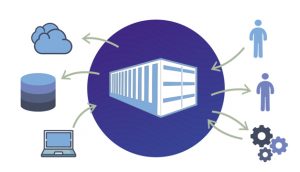Containerizing applications is vital for businesses in a context of technological advances in digital transformation and rapid adoption of the cloud. Enterprise-level containerization of applications includes micro services versus traditional monolithic applications, persistent data storage, and automation of storage management. As companies begin to embrace containerization, the ecosystem of technology tools is evolving and opening the door to a new breeze, to new technological advances. The dominance of digital transformation is evolving daily with a growing pace in public clouds, micro services and DevOps practices.
Recent development in the IT industry has a clear objective: Think beyond digital transformation and adopt a “container-first” strategy for your existing/ new applications. This approach uncovers many hidden secrets to addressing real-world business challenges. Furthermore, the adoption of containerization also helps modern applications to respond quickly to changing market needs.

ADVANTAGES
- PORTABILITY- A container creates a software executable packet that is subtracted from (unrelated or dependent on) the host operating system, and thus, is portable and capable of operating consistently and evenly across any platform or cloud.
- AGILITY- The open source Docker Engine for container operation has launched the industry standard for containers with straightforward development tools and a universal packaging approach which runs on Linux and Windows at the same time.
- SPEED- : Containers are often called “light”, which means that they share the kernel of the operating system (OS) of the machine and are not stuck down by any extra processes.
- FAULT ISOLATION– Each containerized application is segregated and independent of each other. Failure of one container has no impact on the ongoing operation of the remaining containers. Development teams can identify and fix any technical problems inside a container with no down time in other containers.
- EFFICIENCY- The software runs in containerized environments, shares the kernel of the machine’s operating system. As a result, containers have an intrinsically smaller capacity than a virtual machine and require less startup time, allowing many more containers to run on the same computational capacity as a single virtual machine.
- EASE OF MANAGEMENT- Container orchestration platforms can facilitate managerial tasks such as scaling containerized applications, deploying new application releases and monitoring, recording and debugging, among other functions.
- SECURITY- Isolating applications as containers intrinsically prevent the invasion of malicious code from impacting other containers or the host system. In addition, security clearances can be set to automatically prevent undesirable components from penetrating containers or limit communications unnecessary resources.
OTHER BENEFITS
- Less time consuming and more frequent release cycles.
- Improved resiliency
- Compatibility to take advantage of cloud computing.
- Accelerate process and development strategies for new applications (that are ready for commercialization)
- Rationalize legacy application portfolio and upgrade with new functionality and capabilities.
However, modern applications are complex, highly distributed and modular, requiring home owners to modernize on a frequent basis.
In the current scenario, applications include many components such as standardized user interface and background languages, databases, multiple cloud services, and server-free features. Amidst complexity, many companies are trying to integrate hybrid and multi-cloud operating models in order to reduce expenses and gain new access to new cloud-based services. To minimize these critical challenges, businesses need an end-to-end solution to build, deploy and provide modern applications faster and more efficiently in any environment.
The container strategy has been an important part of a company’s cloud transformation, but still many do not succeed in implementing it without complexity.
When you have many applications and servers in service, the need for good container management features to manage virtual environments and automated deployment tools comes into effect. Assessing and planning containerization objectives for the coming months or years can help you to make a firm decision. Containers utilize the common operating system for all applications, but still give personalized experience as they do with virtual machines. This increases density by 5 to 10 times contrary to the above strategy and facilitates the simple deployment of applications, the redeployment model and the reduction of operating costs.
WHERE CAN YOU APPLY CONTAINERIZATION TECHNOLOGY?
Containerization technology can almost help develop any application that might be hard to build on a system natively. Some of the major cases of container usage are mentioned below:
APPLICATION REFACTORING
Containerization technology plays an important role in assisting development and operations teams to take advantage of lifting and moving approaches when migrating required architectures or applications.
CI/ CD SUPPORT
With containers, you can create a simplified development process to build, test and deploy updates or new features with frequent ease. In addition, it reduces the repetition of test cases during execution and prevents the creation of a continuous grouping of file transfers between different systems.
COMPLIMENT MICROSERVICES
Streamline the process of developing and delivering Micro-service applications with containers, because they insulate workload environments. It is easy to decouple architecture with stand-alone workspaces.
WEB SERVER DEPENDENCE
It is not necessary to execute the containers directly onto the host. Rather, it can run on any machine, and the only requirement is to make sure that the host operating system is the same on all systems.
HOW DOES CONTAINERIZATION TECHNOLOGY WORK?
Containers generate code images written to a system and its settings, dependencies, libraries, etc. These pictures work in the form of container motors which can work on any platform.
The purpose of containers is to isolate programmed software from different IT environments. This allows the execution of a code uniformly or uniformly on other platforms independent of its developmental differences in the staging environment and development practices. Containerization technology also acts as a host OS.
TYPES OF CONTAINERS
- DOCKER- An open-source containerized platform that combines the source code of an application with the current operating system and its respective libraries and dependencies. It permits the said code to function on any computer environment.
- LXC- An operating system-based container that allows an application to run on several Linux systems on a virtual level, since it has only one Linux kernel that serves as a host OS.
- CRI-O – This is a container execution interface (IRC) for Kubernetes, a container cluster management platform.
- RKT- A container engine based on applications known as Rocket is used to build contemporary native cloud applications. It uses CoreOS, which works according to the security upgrades that prior versions of Docker were known to have.
